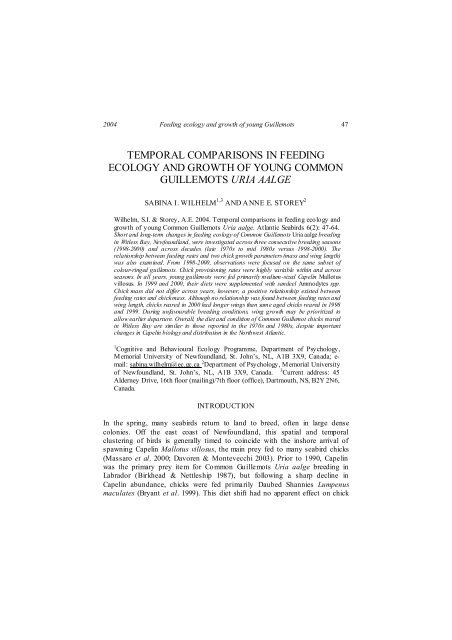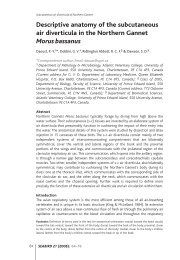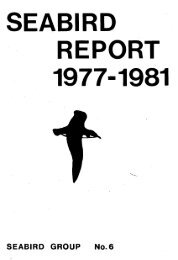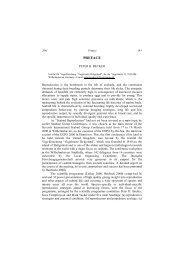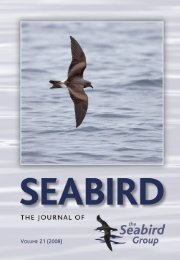Vol 6 No. 2 - The Seabird Group
Vol 6 No. 2 - The Seabird Group
Vol 6 No. 2 - The Seabird Group
Create successful ePaper yourself
Turn your PDF publications into a flip-book with our unique Google optimized e-Paper software.
2004 Feeding ecology and growth of young Guillemots 47<br />
TEMPORAL COMPARISONS IN FEEDING<br />
ECOLOGY AND GROWTH OF YOUNG COMMON<br />
GUILLEMOTS URIA AALGE<br />
SABINA I. WILHELM 1,3 AND ANNE E. STOREY 2<br />
Wilhelm, S.I. & Storey, A.E. 2004. Temporal comparisons in feeding ecology and<br />
growth of young Common Guillemots Uria aalge. Atlantic <strong>Seabird</strong>s 6(2): 47-64.<br />
Short and long-term changes in feeding ecology of Common Guillemots Uria aalge breeding<br />
in Witless Bay, ewfoundland, were investigated across three consecutive breeding seasons<br />
(1998-2000) and across decades (late 1970s to mid 1980s versus 1998-2000). <strong>The</strong><br />
relationship between feeding rates and two chick growth parameters (mass and wing length)<br />
was also examined. From 1998-2000, observations were focused on the same subset of<br />
colour-ringed guillemots. Chick provisioning rates were highly variable within and across<br />
seasons. In all years, young guillemots were fed primarily medium-sized Capelin Mallotus<br />
villosus. In 1999 and 2000, their diets were supplemented with sandeel Ammodytes spp.<br />
Chick mass did not differ across years, however, a positive relationship existed between<br />
feeding rates and chick mass. Although no relationship was found between feeding rates and<br />
wing length, chicks reared in 2000 had longer wings than same aged chicks reared in 1998<br />
and 1999. During unfavourable breeding conditions, wing growth may be prioritized to<br />
allow earlier departure. Overall, the diet and condition of Common Guillemot chicks reared<br />
in Witless Bay are similar to those reported in the 1970s and 1980s, despite important<br />
changes in Capelin biology and distribution in the orthwest Atlantic.<br />
1 Cognitive and Behavioural Ecology Programme, Department of Psychology,<br />
Memorial University of Newfoundland, St. John’s, NL, A1B 3X9, Canada; email:<br />
sabina.wilhelm@ec.gc.ca 2 Department of Psychology, Memorial University<br />
of Newfoundland, St. John’s, NL, A1B 3X9, Canada. 3 Current address: 45<br />
Alderney Drive, 16th floor (mailing)/7th floor (office), Dartmouth, NS, B2Y 2N6,<br />
Canada.<br />
INTRODUCTION<br />
In the spring, many seabirds return to land to breed, often in large dense<br />
colonies. Off the east coast of Newfoundland, this spatial and temporal<br />
clustering of birds is generally timed to coincide with the inshore arrival of<br />
spawning Capelin Mallotus villosus, the main prey fed to many seabird chicks<br />
(Massaro et al. 2000; Davoren & Montevecchi 2003). Prior to 1990, Capelin<br />
was the primary prey item for Common Guillemots Uria aalge breeding in<br />
Labrador (Birkhead & Nettleship 1987), but following a sharp decline in<br />
Capelin abundance, chicks were fed primarily Daubed Shannies Lumpenus<br />
maculates (Bryant et al. 1999). This diet shift had no apparent effect on chick


